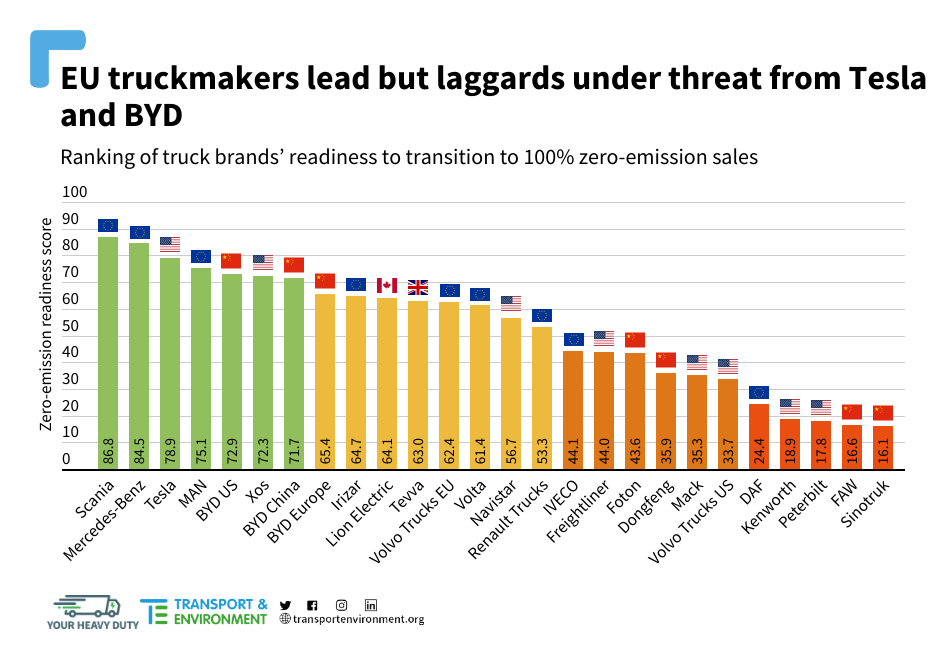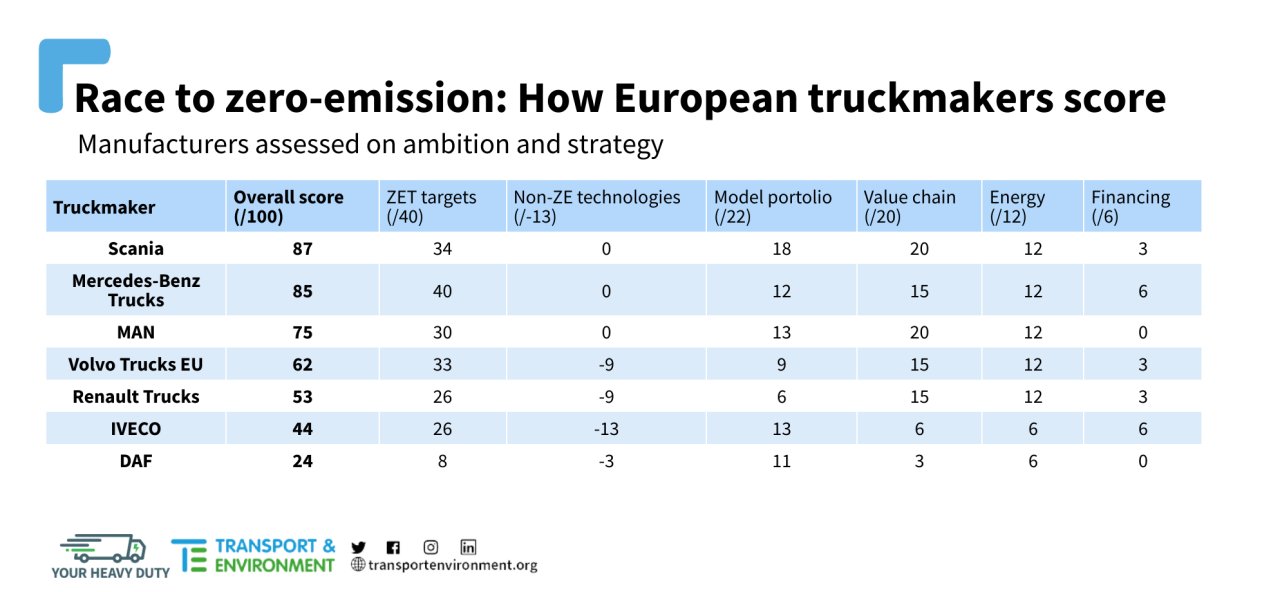
Three European truckmakers, along with Tesla and BYD, dominate a new global ranking of truck brands’ readiness to transition to 100% zero-emission sales¹. Mercedes-Benz Trucks, Scania and MAN all aim to sell only electric or hydrogen trucks by 2040. But green group Transport & Environment (T&E), which compiled the ranking, warned that four major European truck manufacturers lag far behind and risk losing market share to the American and Chinese challengers unless EU truck CO2 standards are tightened.

Scania leads the ranking of truckmakers’ climate ambition and strategies. While it only has a target of 50% of its sales to be electric or hydrogen in 2030, it has a very strong industrial strategy. Mercedes-Benz Trucks, in second place, aims for 60% of its sales to be zero-emission vehicles in 2030. However, there’s a gap between its announcements and its industrial plans. The company has a weaker battery strategy and has yet to secure a supply of battery raw materials. In fourth place, MAN plans a smaller line-up of electric models and has a weaker 2030 zero-emission goal.
Volvo Trucks, the current market leader in zero-emission truck sales in Europe and the US, finishes only mid-table. Despite its ambitious public commitment to reach 70% zero-emission sales by 2030, the company lacks a 100% zero-emission sales target and is investing in gas and biofuels — which still emit CO2. Trailing behind, Renault Trucks aims for half of its sales to be zero emissions by 2030, but it too is hedging on gas and biofuels. IVECO and DAF, which both lack long-term targets and have invested little in battery supply chains and charging networks, are ranked in the bottom half.
Sofie Defour, freight director at T&E, said:
“European truckmakers all claim to be green, but the reality is less than half of them are on track to go to zero emissions and only via voluntary commitments. There’s a huge gap in the truck industry between manufacturers with a plan to fully decarbonise and those without. The EU needs strong truck CO2 standards to bring the whole European industry up to speed.”
European truck manufacturers face stiff competition from Tesla and BYD, which have already proven their ability to rapidly scale up zero-emission manufacturing in the cars market. They have also built strong battery supply chains including securing supplies of raw materials.
California’s 2036 diesel truck sales ban and the US Inflation Reduction Act could lead to truckmakers prioritising vehicle and battery production investments in America, the report also warns. This might result in truckmakers’ current voluntary commitments being changed or delayed. T&E said the EU needs to use the revision of its CO2 emission standards for heavy-duty vehicles to signal investment certainty in Europe and ensure truckmakers’ commitments are not abandoned. A higher 2030 target will be crucial to push manufacturers to rapidly improve their industrial strategies in the EU.
Sofie Defour said: “Tesla and BYD are poised to repeat their success in the truck market while Californa has sent a clear signal to truckmakers. That should set off alarm bells for European lawmakers who don’t want investments in manufacturing and batteries to go elsewhere. The EU must use its truck CO2 standards to give certainty to truckmakers to go zero emissions and invest in Europe.”

Earlier this month, T&E launched the Your Heavy Duty campaign, to advocate for higher CO2 reduction targets for European trackmakers to encourage investments, scale up supply and deliver on zero-emission trucks. The campaign is calling on EU lawmakers to:
- Set a CO2 reduction target of -65% in 2030, in line with what leading manufacturers have already announced.
- Set a CO2 reduction target of -100% in 2035 for freight trucks to ensure the last polluting vehicles will be off Europe’s roads in 2050. Without a similar target to California’s 100% mandate in 2036, the EU risks falling behind as major truckmakers could shift investments away from Europe.
- Keep fuels out of the CO2 standards: biofuels and e-fuels are expensive, false climate solutions to decarbonise new trucks. Truckmakers opposed to including fuels in the regulation make up over 90% of the market, with only laggards in favour of such a scheme.
- Extend the scope of the regulation to small trucks, vocational and non-certified vehicles, so that all new trucks are regulated.
¹ T&E ranked European truckmakers’ readiness to transition fully to zero-emission truck sales. The ranking assesses the compatibility of their voluntary zero-emission sales announcements with climate needs, and the extent to which they are aligning their industrial plans and business activity with those targets. It also looks into how European manufacturers perform compared to their counterparts in the US and China, assessing who is best positioned to win the ongoing global race for leadership on commercial vehicle technology. The research ranks individual truck brands rather than OEM groups.
Republished by Transport & Environment.
Report: Ready or not — Who are the frontrunners in the global race to clean up trucks?
Your Heavy Duty
The challenge
Heavy-duty vehicles (HDVs) are responsible for 27% of climate emissions from road transport in Europe, while only accounting for 2% of the vehicles on the road. Trucks and buses emit four times more CO2 than all flights inside the EU and would be the 6th largest emitter if they were an EU country. Equipped with diesel engines, they increase global warming and pollute the air, causing serious diseases and premature deaths.
If no action is taken, these emissions will continue to grow. The European Commission expects truck activity in the EU to further increase by 40% between 2019 and 2050, while activity from buses and coaches would grow by 10% over the same period.
On the wrong road
To address this, the European Union is proposing targets for truck and busmakers to cut CO2 emissions from new sales by 45% by 2030 and 90% by 2040. They can do this by increasing the share of zero-emission vehicles (ZEVs) sold, including battery electric (BEVs), fuel cell electric (FCEVs) and hydrogen combustion vehicles.
A climate reduction target of -90% might seem close to full decarbonisation at first sight. But due to a number of shortcomings, the proposal would only reduce emissions from HDVs by 56% by 2050. This falls far short of the EU’s climate ambitions and seriously undermines Europe’s chance to retain its industrial leadership of the sector.
Winning the race
The European Union must cut CO2 emissions of new trucks by 65% by 2030 and 100% by 2035. That’s what it will take for Europe’s truckmakers to win the global competition to reach zero emissions. It’s also necessary for the EU to get the last polluting trucks off its roads by 2050. Trucks are driven for 20 years on average.
This is the YOUR HEAVY DUTY campaign. We want to raise awareness of the major role trucks play in decarbonising our road transport sector. The aim is to show the European Parliament and EU countries why they should vote for higher CO2 standards for truckmakers. Everyone will benefit. Hauliers and freight buyers can accelerate the transition by shifting to zero-emission trucks in their fleets. Drivers and workers will benefit from safer and healthier equipment to work with. Citizens will breathe cleaner air.
Let’s raise our voices and fight together for a better world
Join citizens across Europe in demanding responsible action towards reducing transport emissions by sharing our promotional materials and tagging your EU representatives.
It’s Your Heavy Duty!

Republished by Transport & Environment.
Sign up for daily news updates from CleanTechnica on email. Or follow us on Google News!
Have a tip for CleanTechnica, want to advertise, or want to suggest a guest for our CleanTech Talk podcast? Contact us here.
Former Tesla Battery Expert Leading Lyten Into New Lithium-Sulfur Battery Era — Podcast:
I don’t like paywalls. You don’t like paywalls. Who likes paywalls? Here at CleanTechnica, we implemented a limited paywall for a while, but it always felt wrong — and it was always tough to decide what we should put behind there. In theory, your most exclusive and best content goes behind a paywall. But then fewer people read it! We just don’t like paywalls, and so we’ve decided to ditch ours.Unfortunately, the media business is still a tough, cut-throat business with tiny margins. It’s a never-ending Olympic challenge to stay above water or even perhaps — gasp — grow. So …




